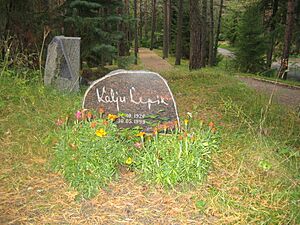Kalju Lepik facts for kids
Quick facts for kids
Kalju Lepik
|
|
|---|---|
| Born | 7 October 1920 Koeru Parish, Järva County, Estonia
|
| Died | 30 May 1999 (aged 78) |
| Occupation | Poet |
| Years active | 1939–1999 |
| Spouse(s) | Asta Lepik |
Kalju Lepik (born October 7, 1920, in Koeru Parish, Estonia – died May 30, 1999, in Tallinn, Estonia) was an important Estonian poet. He spent most of his life living outside his home country as an exile. This means he had to leave Estonia and live somewhere else, often because of political reasons.
Early Life and Moving Away
Kalju Lepik started writing poems when he was young. His first poems were published in 1939 in student magazines in Tartu, Estonia. These magazines were called Iloli and Tuleviku Rajad (which means 'The Paths of Future').
In 1940, he helped start an art group called Tuulisui. This group continued its activities even after he moved to Sweden in 1945. During World War II, in 1943 and 1944, he was part of a military unit. After the war, in 1944, he became a refugee. This meant he had to leave his home country to find safety. He then settled in Stockholm, Sweden, where he lived for many years.
Life in Exile
While living in Sweden, Kalju Lepik worked hard to support other Estonian refugees. He wanted to make sure their rights were protected. In 1946, he started a publishing company in Stockholm called Eesti Raamat. This company helped publish books by Estonians living outside their homeland.
Later, in 1966, he became the head of the Baltic Archive in Sweden. This archive collected important documents and information about the Baltic countries, including Estonia. From 1982, Lepik was also the leader of the Estonian Writers' Union in exile. This was a group for Estonian writers who lived outside Estonia.
Kalju Lepik received several awards for his writing. He won the Juhan Liiv poetry prize in both 1990 and 1998. He also received the annual prize for Estonian literature in 1998.
His Poetry Style
Kalju Lepik's early poems showed a strong love for his home country. They were very patriotic and full of passion. He also used satire in his writing, which means he used humor or exaggeration to criticize things.
As he got older, his poetry changed. His later poems often had more pessimistic elements. This means they sometimes showed a feeling of sadness or that things might not turn out well. In his final years, he slowly moved away from political topics in his poems. He also softened the strong patriotic feelings he had shown earlier.
Kalju Lepik was married to Asta Lepik. They had a daughter named Aino Lepik von Wirén, who was born in 1961. She later became an Estonian politician and diplomat. Kalju Lepik's last poetry collections were published in Estonia. He returned to his home country and passed away there in 1999.


